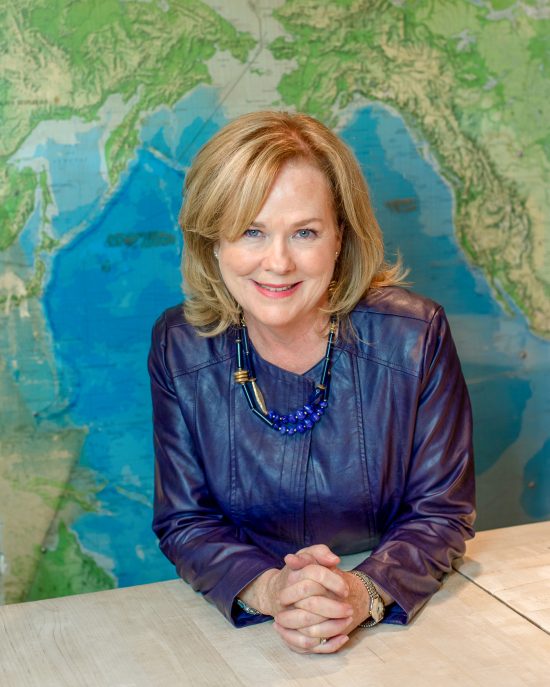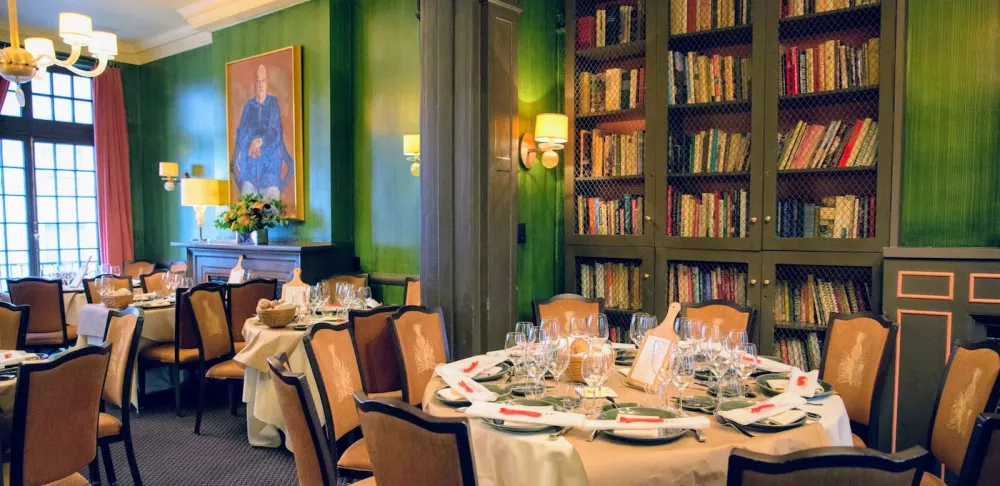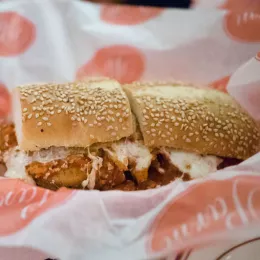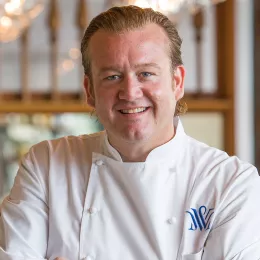In 2006, Susan Ungaro, the former editor in chief of Family Circle Magazine, became president of the James Beard Foundation (JBF), a nationally renowned nonprofit foundation and culinary arts organization dedicated to celebrating, nurturing, and honoring chefs and luminaries in the culinary industry.
 Since beginning her tenure, Ms. Ungaro has been instrumental in helping the foundation thrive, tripling its annual revenue from $4 million to $12 million and erasing a previous deficit of over $1 million.
Since beginning her tenure, Ms. Ungaro has been instrumental in helping the foundation thrive, tripling its annual revenue from $4 million to $12 million and erasing a previous deficit of over $1 million.
Five years ago, she launched the Taste America cross-country tour. Other forward-looking initiatives she’s established include the annual JBF Food Summit, the Leadership Awards, and the JBF Chefs Boot Camp for Policy and Change, as well as structures to recognize women in the field, such as JBF’s Women in Culinary Leadership program and the Women's Entrepreneurial Leadership program.
Among other honors, Ms. Ungaro was named one of Adweek’s 30 Most Influential People in Food and one of Irish America’s Top 50 Power Women; she also received the Hope Award from the National Center for Missing & Exploited Children.
She has appeared on Food Network's Beat Bobby Flay, Iron Chef America, Top Chef, the Today Show, Good Morning America, and many more. Recently, we caught up with Ms. Ungaro at the James Beard Foundation’s West Village headquarters to discuss her career and her work with the nation’s most celebrated food organization.
Tell us about your start and how you came to food and hospitality.
If you look around the room, I have little elements of my past life. For example, I have a bobblehead Ronald McDonald. That's where I got my start in the food industry—working my way through college at McDonald's. I was a communications major—radio, TV, and print journalism—and when I graduated, I got my master's from William Patterson, which was then a state college, in New Jersey.
I actually started an employee newsletter for the McDonald's franchise I worked for. I was slinging hamburgers, making shakes, frying fries, managing. By the time I left, I was a shift supervisor. I knew I didn't want to stay at McDonald's, so I sent out my resume and ended up getting a job as an editorial assistant at Family Circle magazine, a big women's magazine in New York City.
I was an editorial assistant, and eventually became a senior editor—I worked my way up. I was at Family Circle for 27 years. When I was seven months pregnant with my third child, my daughter, I became editor in chief. At the same time, I got married and bought my first house, learned how to decorate. I even learned how to cook from all of the magazine's recipes and the test kitchens. But I was in charge of the reportage—the articles department—not the food or home or beauty departments.
Still, 25 percent of our editorial was food-focused. You name a chef on television or a major cookbook writer—from Bobby Flay to Emeril Lagasse to Ina Garten to Rachael Ray—and they wanted to get their recipes featured in Family Circle, because we had over 20 million readers. When I left Family Circle, I knew I didn't want to be in publishing again—I had done that for 27 years.
I loved what I did, but during that time I'd also been on the board of trustees of a few foundations. So I knew I wanted to run a foundation, but the James Beard Foundation was not on my radar at all. I was much more involved in child health, homeless families, feeding the hungry, things like that.
But in life, and in cooking, timing is everything, as they say. So when I left, one of the Family Circle’s board of trustees, Barbara Fairchild, then the editor in chief of Bon Appétit, put me in touch with JBF’s board, and I ended up coming here in April 2006.
You've led the James Beard Foundation for 11 years. Has it been what you expected when you first arrived?
No. I don't think you really understand the job until you are in it. I came knowing JBF needed a turnaround. It was financially in a difficult position, losing money. And I didn't just want to come to the James Beard Foundation because it was known for the James Beard Awards and scholarships.
What I also loved was that James Beard was truly an everyman. He liked fried chicken and down-home cuisine just as much as he loved foie gras and haute cuisine. As an editor, you know how to create stories. We needed good PR, and that was part of the mission. I had an expression: "We're going to take it mass with class."
For example, Vogue is obviously the height of fashion, but its readership is mass. And I felt that the James Beard Foundation was the height of great food, but it needed to be more mass. More people needed to know how important a James Beard Award was, and what it meant for chefs to be artists.
Food Network had been on the air for just over a decade. Chefs were becoming the new popular celebrities, and I knew how to make sure they became even more popular and part of the culture, not just fine dining. Chefs are the great spokespeople today for food policy, and advocates for better nutrition and better school lunches—it has only grown. So we rode that wave too.
In a sense, you might say you're the manager of both a foundation and a restaurant.
That first week, somebody was coming to visit me here at the Beard House. The front reception area can get kind of messy until right before dinnertime, with boxes and things being delivered, so I wanted to make it look a little nicer. Albert, our night kitchen manager, was sitting and reading the Post.
So I went downstairs and said, "You know, Albert, I’m expecting some company. Can you clean up this room?" He looked at me and said, "I haven't clocked in yet." I had this aha moment—I was back in McDonald's, where people had to clock in. That was really the moment when I realized I was running what would now be called America's first pop-up restaurant. The Beard House is a place where the restaurant, the menu, and the chef change every day.
What does bringing the James Beard Foundation experience on the road via the Taste America tour entail?
We're celebrating chefs in the cities that we're visiting. In Boston last weekend, we were celebrating Karen Akunowicz [2015 and 2016 James Beard Award Nominee for Best Chef Northeast] and several other local chefs. Then we bring a chef from outside the city, so we have local stars, and what we call our All-Star, a national star.
So in Boston, we had Daniel Boulud. He came and they created a beautiful dinner together. It's always a big fundraising dinner with auctions, a cocktail hour, and a five-course menu. Then the next day, we went to Sur La Table stores, where we had two free cooking demos and book signings with the two chefs who participated the night before.
So Daniel Boulud showed people how to make this incredible lobster in a chilled broth called homard en gelée, and Karen Akunowicz's demo was scallops with a Thai salad—really interesting. In Chicago the week before, we had Michael Voltaggio, who has a restaurant in San Francisco, and won Top Chef. He was our visiting star. Our Local Star was Stephanie Izard, of Girl & the Goat, the first woman to win Top Chef.
How do all these activities carry out the mission of the James Beard Foundation?
We spread culinary knowledge. For example, we grant scholarships to students all across the country. Since 1991, we have awarded over $7 million in scholarships. When I came, the average annual amount of scholarships awarded was $150,000 to $200,000. Now it's more in the $700,000 range. Plus we're taking the Foundation's name on the road, featuring rising chefs, so people know that these chefs have something to do with a man who was considered the godfather of American gastronomy.
James Beard wrote over 24 cookbooks. One of the things I am proudest of is that more and more people know who he was and what he stood for, because we've made the Foundation's footprint national. Bringing the Beard House experience on the road makes us more “mass with class.” This spring, the PBS series American Masters did a Chefs Flight series—four chefs, four one-hour documentaries on PBS: Jacques Pépin, Alice Waters, Julia Child, and James Beard.
The documentary on James Beard was called America’s First Foodie. I'm really proud of that, because it means we're getting his name out. People know who he is. When they walk into a restaurant and they see a James Beard Award medal or certificate on the wall, they know, that means something.
Tell me about what the James Beard Awards mean and why they matter.
The James Beard Awards are the most coveted awards a chef can get in this country. Obviously, Zagat and the Forbes Travel Guide are different honorifics, but Michelin is only in four cities. It's only in New York, Chicago, D.C., and San Francisco. But the James Beard Awards are national.
Many chefs will say publicly that a James Beard Award changed their life because all of a sudden, reservations were up in their restaurants; someone wanted them on TV doing cooking demos, just like James Beard used to do on the old Today show in New York City; and they might even get a book contract. It's an affirmation by their colleagues.
Yes, there's an open call for entries, but ultimately you are voted on by a jury of your peers and journalists. My first awards in 2006 were at the Marriott. It was a great celebration, but publications like the New York Times had referred to it as the Oscars of the food industry, and it didn't feel like it.
So the next year, we moved it to Lincoln Center. It became a red-carpet event, a reason to dress up. It elevated the awards, the chefs, the restaurateurs, and the media. And a few years ago, we moved the awards to the Chicago Lyric Opera House. It is still the most glamorous night for the food industry in America.
Can you talk about moving the awards to Chicago?
There are 10 Regional Best Chef Awards, for 10 regions of the country. They're national awards. Even though the Beard House is in New York City and the awards had always been in New York City, it was good to move out. We also moved the nomination announcements to different cities. The day the nominees are announced is a big day around the country. That’s why we visit other cities to do the announcements. [Ed. Note: In 2017, ICE hosted the James Beard Foundation’s annual Chefs’ Night Out celebration, to give chefs, nominees, presenters, and their supporters a chance to mingle before the big awards ceremony.)
Is there a consistent trait you see in the chefs who win a James Beard Award? What makes them outstanding?
Number one, obviously, is that they're getting great reviews in whatever city they hail from. Their peers are looking to them as leaders in whatever they're doing culinarily, in their restaurant, in how they're presenting their food. There may be some trends that they are expanding on, or maybe they're just doing something that is so beautiful and different that they're being held up by their colleagues and voted on.
Which chefs stick out in your memory?
To me, every chef who comes and cooks at the Beard House. For many of them, it's their New York debut. Julia Child said this, not me: Bringing a chef to cook at the Beard House is like inviting a singer to come and perform at Carnegie Hall. It has been such a treat to meet some of our country’s iconic chefs. Jacques Pépin—it's just so special to be with him. Charlie Trotter, who sadly passed away—we had some memorable times honoring him at the James Beard Awards.
For our 30th anniversary, Marcus Samuelsson was basically the keynote, because he came and cooked at our 30th anniversary dinner at the Beard House, and it happened to be his 25th time cooking here. [The dinner will be featured in 30 Years: A Celebration of the James Beard Foundation, on ABC.] All of these chefs are special in their own ways. How do you choose your favorite children? You can't.
What might surprise people about what the Foundation does?
We are a place where anyone can come to dinner. We even have a student membership, for $25. Anyone can go online and see who is cooking at the Beard House. In general, a dinner costs $175. That includes everything: tip, wine pairings, champagne, and cocktails. And if you're a member, you're paying less—generally $135. To have an incredible dining experience—to go out to dinner in New York with five courses with wine pairings—is going to cost a whole lot more than that. And we have our “Foodies Under 40” program, called “JBF Greens,” in New York and Chicago. Membership is $75, and those events are also fantastic.
What’s something that young or aspiring chefs might not realize about this industry?
Chefs are actually kind, nurturing people, despite what the public image might try to make of them. Sure, it takes all kinds to make this world, but in general, I've always felt that chefs, whether they're men or women, are like mothers. What do they want? They want to feed us and nurture us.
The majority of chefs that I've met—even the ones with big, bawdy reputations—want to create the next, best generation of chefs. So you should be looking for role models who fit your ideals. When you go work in a place, if it doesn't feel right, leave and go somewhere else. In these times, that's even more important.
Tell me about how you overcame some of the major challenges you've faced as head of this foundation.
I didn't look back. I looked forward. When I took this position, my oldest son was in medical school. It was the white-jacket moving-up ceremony at Mount Sinai, and they had a pediatric cardiologist from Texas giving the keynote to these wide-eyed, ambitious, and idealistic young people who want to be doctors. This doctor's job was to do heart surgery on babies, on children. And he said the children who did the best were the ones that had parents who were irrational optimists. I'd never heard those two words put together before—irrational and optimist.
I realized that's what I'd done, because I had been at the Foundation for just a year and a half, and things were already turning around. If you are an optimist, try to keep those other voices—“It can't be done, it's never been done”—out of your head. Think that you can do anything—that really does help you succeed. It's easy to be an optimist when it's a sure thing. It's not easy to be an optimist if it's not that rational at the time.
You’re stepping down as president at the end of 2017, at the conclusion of the Foundation's 30th anniversary year. What's next for the Foundation, and for you?
Well, I'm not calling it retirement, but a “rewiring”—because honestly, I don't know. It's nice to be able to say, “I'm going to see what comes to me.” I had some time off between Family Circle and the James Beard Foundation, and at the time, all I knew was that I wanted to do something to give back. That’s what I know now as well. I can imagine myself helping other foundations that need my help, but I'm also looking forward to not working “36/7.”
And for the Foundation, we're poised for even greater things to come. We'll be giving out more scholarships. We'll be doing more in the areas of food policy and advocacy, in which we've taken a big leap. We've been working very hard to create a more diverse restaurant and food world. And our Women's Leadership Program is growing and having an impact; we want it to be even better than it is right now.
Do you have some final words of wisdom for people entering this career?
I'll use something that I used even before I came to the James Beard Foundation: The ten most important two-letter words are: ‘If it is to be, it is up to me.’ Ultimately, in every aspect of our lives, we're in charge of ourselves—no matter what’s happening around us. That's a really important life lesson to take, no matter where you go. And I'll give you one other bit that my father used to say: Be like a tea bag. You get stronger the longer you're in hot water.
Ready to launch your career in the culinary arts? Learn more about ICE's career training programs.




